| | Spring triticale for silage | Winter triticale for silage | Triticale silage quality and yield | Silage mixtures and harvest stages | Best management practices for ensiling triticale forage
Spring Triticale for Silage
- Spring triticale for silage is competitive with other silage options in Western Canada and in other countries, both for quality and for yield. Under stress, including drought and high temperatures, excess moisture, acid soils or excess of soil nutrients, triticale will maintain its yield potential and straw strength compared to barley or oats. Barley or oats may have less drought tolerance and weaker straw than triticale.
- Best management practices for growing and harvesting spring triticale silage are different than for barley silage. The two crops develop very differently and have very different straw characteristics, with triticale stems being more lodging resistant.
- When harvested after heading, spring triticale generally ranks between oats and barley for quality. As with other cereals, earlier silage harvest (optimum soft dough) improves quality and protein content but at the price of potential yield.
- Depending on conditions, spring triticale intercropped with peas may yield as well as triticale does by itself. However, the pea content in the silage usually results in a significant increase in the protein content as compared to that found when triticale is grown alone.
Winter Triticale for Silage
- Fall-planted winter cereals such as triticale and rye provide a valuable source of forage when spring grazed prior to being harvested for silage or seed. Rotating winter cereals with barley silage crops offers breaks for disease and pest control.
- When winter triticale is grown in a spring seeded inter-crop with spring oats or barley, the silage yield may sometimes decrease. However, if the crop is left for late summer and fall re-growth, the silage plus pasture yield usually exceeds the yield of either mixture component grown separately. It also provides fall grazing.
- If using oat inter-cropped with spring-seeded winter triticale, the expected forage yield performance is mixture = oat > winter mono-crop. This is especially true when seeding early.
Triticale Silage Quality and Yield
- In Alberta, overall protein expectation for protein content in annual silage crops is described as: oats (9 percent) < barley, spring rye and triticale (10 percent) < sunflower (12 percent) < field peas (18 percent) < fababean (20 percent +).
- Canadian feedlots occasionally report reduced intake and/or gain from triticale silage as compared to barley. These probably relate either to change of feed, or to samples being harvested at non-optimal stages, or to samples being inadequately chopped or packed. Further research is needed on this topic.
- Compared to other silage, reduced intake is often reported as an issue in feeding triticale. This does not always translate into reduced animal productivity or quality. Improved triticale silage management and processing (a short chop length) can reduce this problem. Varieties with rough awns should be avoided for green-feed or haylage, or should be cut earlier before awns become hard and thick. The winter triticale ‘Bobcat’ is the first semi-awnless variety specifically bred to reduce this problem.
Reduced awn triticale
The reduced-awn characteristic of the winter triticale Bobcat is a very desirable trait. The lack of awns may reduce mouth irritation and sores if the crop is harvested after the optimum maturity date for good quality silage.
A study on barley by Karren et al (1994) advised against using rough-awned semi-dwarf barley in cattle silage because it can cause mouth lesions if silage is harvested at mature stages or moisture content is too low. The semi-awnless variety Bobcat was released to address any potential problems with awns. Harvesting silage at the recommended stage will eliminate this problem.
Reduced awns will be a feature found in future triticale varieties bred for forage use. It is anticipated that more reduced awn spring triticale varieties will be registered in 2005.
Triticale silage yield
In Alberta trials, triticale silage productivity is usually rated as being better than barley. Extension information from Manitoba does not support this superior rating.
In silage yield comparisons between 20 registered barley and triticale varieties and experimental lines grown at Lacombe, Alberta between 1998-2000, researchers found that:
- The dry silage yield of triticale averaged 14,324 kg/ha (minimum 12,812 kg/ha; maximum 16,137 kg/ha.
- This converts to 12,758 lbs/ac (min. 11,411 lbs/ac to max. 14,373 lbs/ac).
- The barley silage yield averaged 13,346 kg/ha (minimum 10,903 kg/ha; maximum 14,675 kg/ha).
- This converts to 11,887 lbs/ac (min. 9,711 lbs/ac to max. 13,070 lbs/ac.
Triticale silage quality composition
Alberta trials have shown equal or better productivity when beef and dairy herds are fed triticale silage compared to other silages. In some studies, productivity was equal to or better than other silages despite lower intake of triticale silage compared to other forage silages such as barley and alfalfa.
Triticale is particularly well adapted for high forage yield production on heavily manured fields, where it is also an efficient remover of excess soil nutrients. Harvesting protocols and timing must be adjusted to accommodate the differences between triticale and barley in these situations. In high productivity systems where lodging is a problem, triticale should be compared to semi-dwarf barley, which also has special adaptation to high fertility conditions.
Using book values to determine nutritive value of cereal silage should only be used for comparison, as nutritional values are best determined by feed testing. This is because of:
- Quality variation affected by harvest date (in green-feed and for silage).
- Variable mixture compositions, when results from different crop mixtures are reported.
Due to variation in harvest dates, crop type and environmental conditions, nutritional value can only be determined by appropriate sampling and feed analysis. Typical compositional values for Alberta-grown silages are indicated in Table 17.
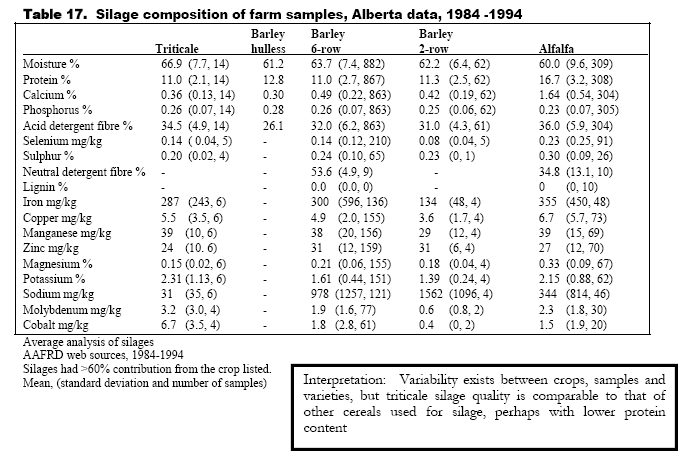
In silage, an acid detergent fibre (ADF percentage) level exceeding 39 percent would be rated as fair or poor. In multiple farm trials by Alberta Agriculture, Food and Rural Development in 1999-2002, no value for triticale ever exceeded 37 percent. This confirms the high energy potential of triticale as a forage source (Table 18, Figure 10).
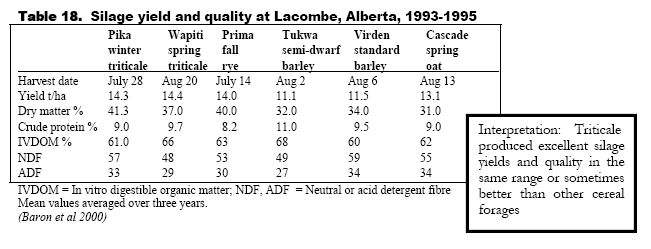
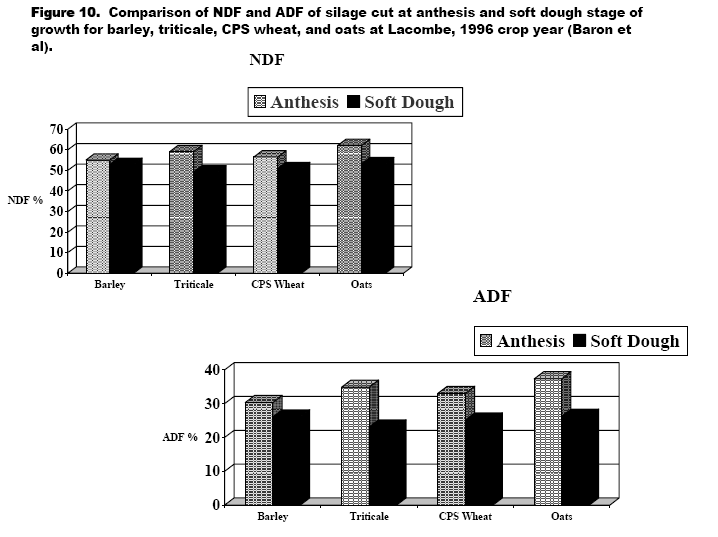
In a Canadian study, Zobell et al (1992) compared barley and triticale silage fed to 120 steers as 25 percent of the ration, combining it in the diet with either barley or high-moisture barley.
No differences in weight, daily gain, dry matter intake or feed efficiency were found between the two diets. They concluded that “triticale silage can be fed to replace barley silage at moderate levels in growing steer rations containing barley grain.”
Silage Mixtures and Harvest Stages
In Alberta, forage-clipping studies by Juskiw et al (2000) estimated potential silage productivity at different harvest dates. The researchers tested Wapiti spring triticale in mixtures at various seeding rates with Noble barley and AC Mustang oat.
They found that:
- Forage yields of the mixtures were generally in the middle of the yields of the components, or not different from one or the other component.
- The date for optimum harvest was generally in the middle of the dates of the components, or not different from one or the other component.
- Forage quality of the mixtures was also generally intermediate, with higher sample quality from higher amounts of leafy tissue in the sample, and with an earlier harvest.
- Higher seeding rates tended to increase forage yields. Seeding rates are dependant on soil type and moisture conditions. For example, for black and grey wooded soils with adequate moisture, 25 to 28 plants per square foot or 250 to 280 per square metre is optimum.
The Ontario Ministry of Agriculture, Food and Rural Organizations (OMAFRA) website describes similar findings for Ontario conditions. The site also says that harvesting at the soft dough stage results in the highest energy production per acre.
Triticale:pea silage mix
Spring triticale can be grown as an admixture with peas to raise the protein content. However, trials at Lacombe from 1981-1983 (Berkenkamp and Meeres, 1992) found that in comparison to pea mixtures with other spring cereals, the yield potential (t/ha) by crop was ranked as:
- Oat (12.0 t/ha)
- Wheat (8.8 t/ha)
- Barley (8.2 t/ha)
- Triticale (6.6 t/ha)
In these studies, the mixtures were seeded at 90 kg peas plus 20 kg per hectare cereal. None of the mixtures exceeded the yield of mono-cropped oats.
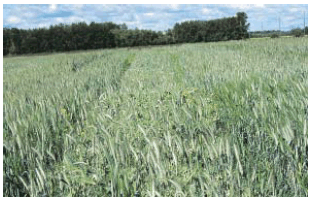
Photo - Pea/Pronghorn triticale mixture
Studies by Blade and Lopetinsky (2002) at four locations found variable yield performance for barley and triticale in mixtures with peas. Yields depended on location and site yield potential (Figure 5). Although results were variable at different locations, including peas in the mixture usually increased the protein content in the harvested silage; this sometimes came at the expense of silage-yield-per-unit-area (Figure 6).
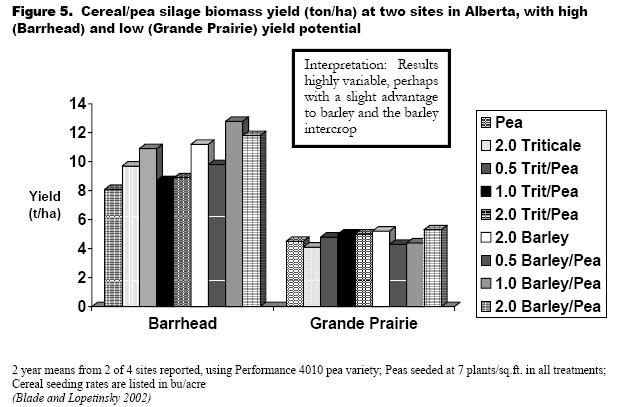
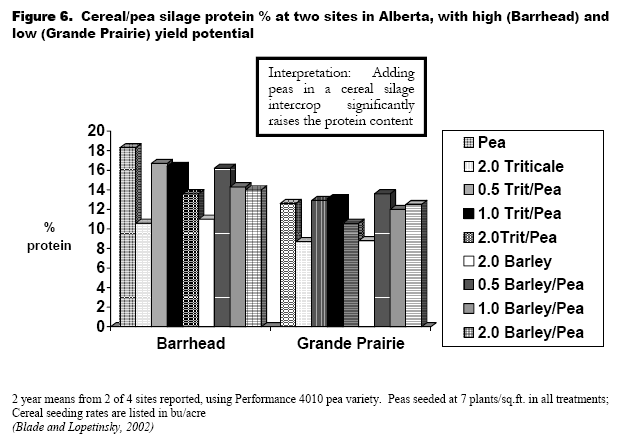
Silage harvest stage for dairy cattle
In recent Canadian work, Kennelly and Khorasani (2000) compared barley, oat, triticale and an inter-cropped triticale/barley silage, and monitored the effect of harvest date on silage quality. They recommended that the optimum time for harvest was at the soft dough stage in order to best balance potential quality and yield.
Data from Baron (Figure 7) clearly show that triticale silage quality is midway between barley and oat for all likely silage harvest dates.
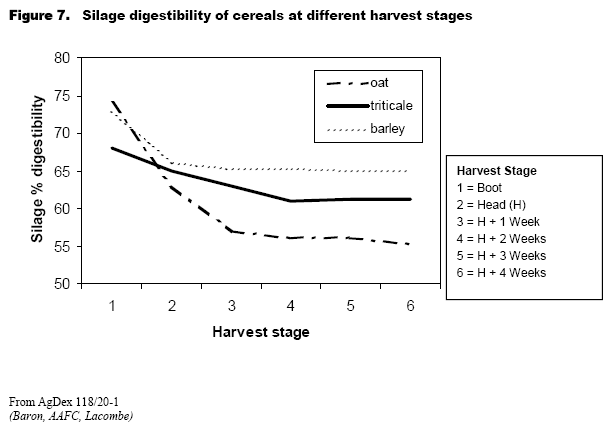
Figures 8 to 10 show comparisons of silage yield, protein, NDF and ADF of various cereal silages cut at anthesis (flowering) and at soft dough stages of growth.
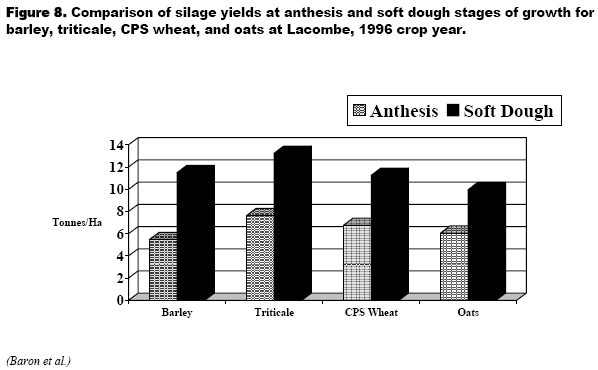
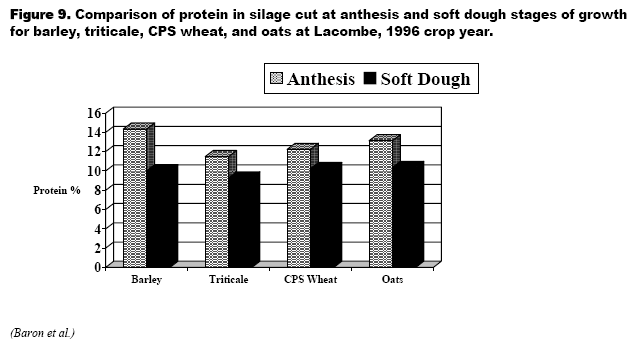
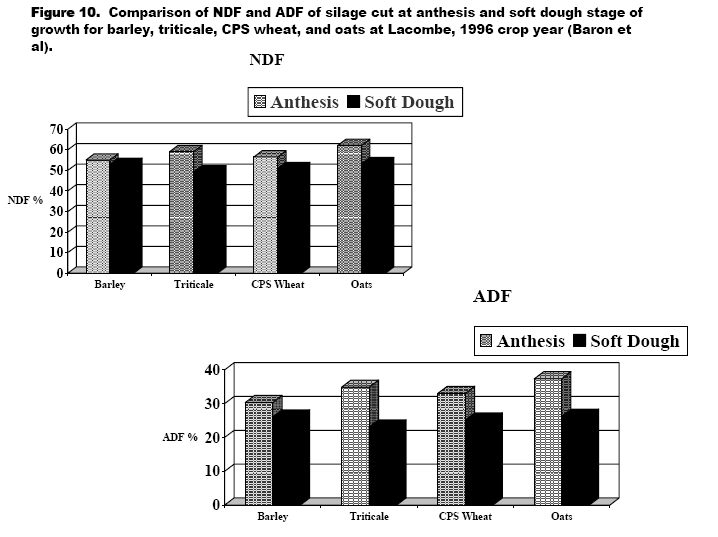
Best Management Practices for Ensiling Triticale Forage
- Use different crops and varieties to spread the timing for optimum harvest of silage in different fields.
- Use the varieties that have the highest grain yield. Grain yield and forage yield are highly related.
- Whether using horizontal silos, towers or plastic tunnel bags, harvesting should be completed before the standing crop reaches 60-65 percent moisture content. The soft dough stage is a good harvest target.
- Earlier harvesting improves silage protein but lowers potential harvestable yield and energy.
- Avoid harvesting after the mid-dough stage, as the higher fibre content negatively affects energy content.
- If you need high protein silage, harvest earlier than the mid-dough stage.
- Triticale stems are tougher than barley and may need more processing to get optimum feed acceptance. Slow down harvesting speed to compensate for chop length.
- Cut, chop triticale silage so that plant cells are damaged. Chopping reduces silage losses. The smaller the pieces, the easier it to is to exclude air when packing. Livestock also find smaller pieces more edible (.75 to 1.25 inches or 1.9 to 3.2 cm).
- Fill silos rapidly. Pack and seal them quickly to avoid exposure to air, and to promote bacterial action and lactic acid fermentation.
- Use silage additives when necessary to improve silage quality and utilization.
The following tables and figures show comparative silage quality and productivity from Canadian research trials. Interpretations from the data are also presented in abbreviated form.
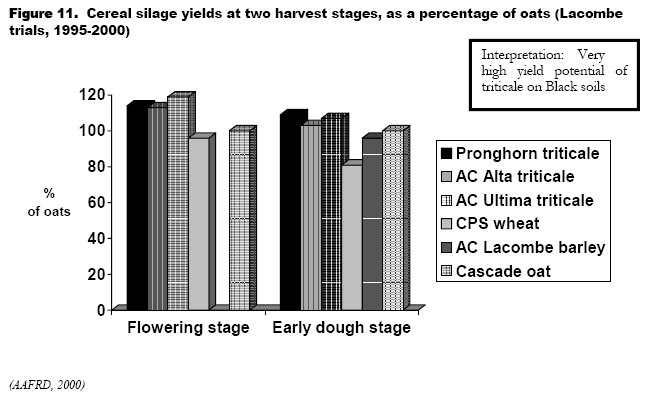
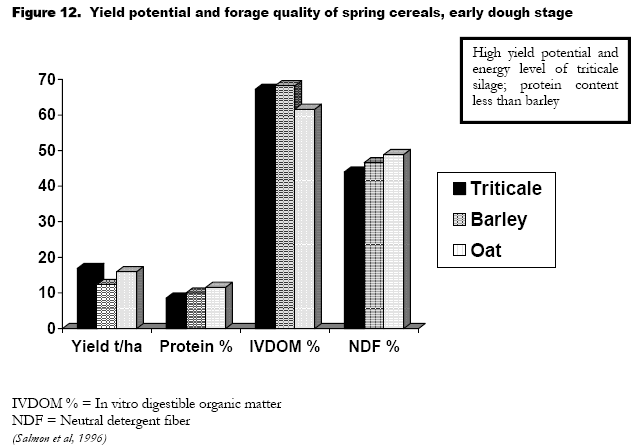
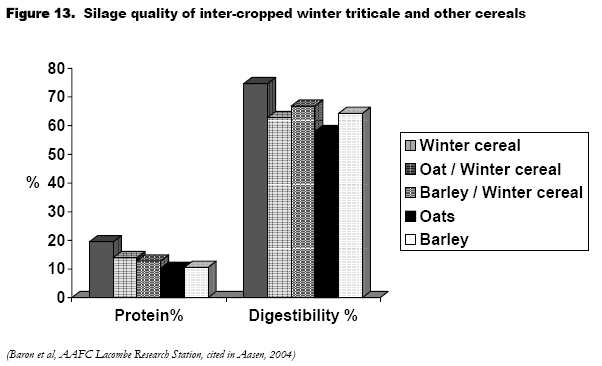
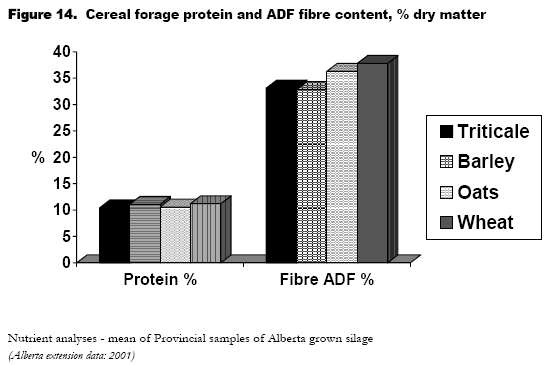
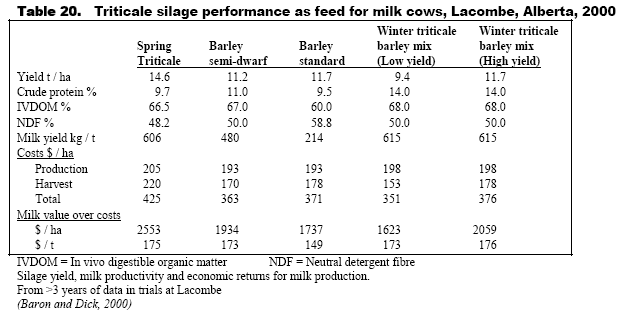
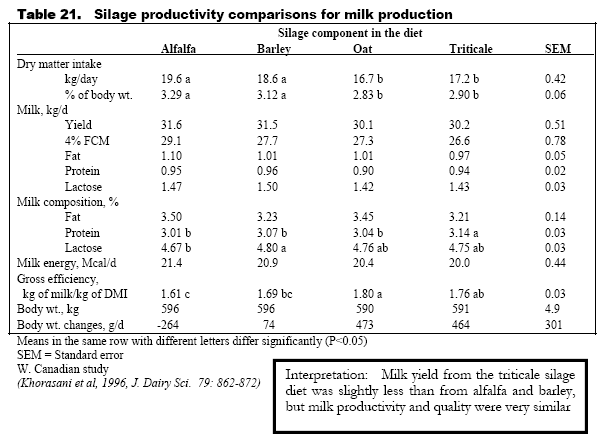 |
|